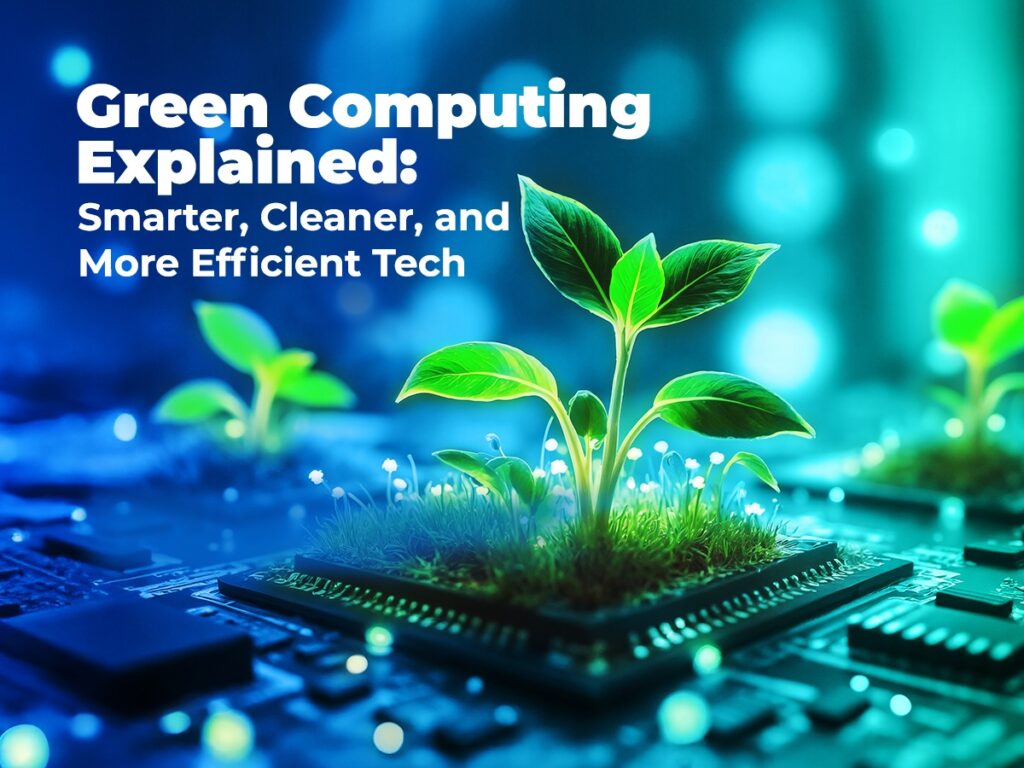Green Computing Explained: Smarter, Cleaner, and More Efficient Tech

Introduction
The modern world is built on technology, but the rapid expansion of the tech sector comes with a steep environmental cost. As businesses rely more on digital infrastructure, the demand for energy and resources has skyrocketed, leading to higher carbon emissions, increased energy consumption, and a growing mountain of electronic waste.
Green computing is our solution to this problem. It’s a vital, strategic approach that integrates eco-friendly practices into the very core of technology, aiming to balance innovation with environmental responsibility. This philosophy is implemented through three key pillars: Green Cloud Computing, Green Internet of Things (IoT), and Sustainable Big Data Analytics.
The Pillars of Sustainable Computing
- Green Cloud Computing
Cloud computing has revolutionized how we access and manage data, but its massive data centers are enormous power consumers. Green cloud computing is all about making this infrastructure as efficient as possible. By pooling resources over the internet, cloud providers can reduce the need for individual businesses to maintain their own energy-intensive servers.
Key strategies for achieving this include:
- Energy-Efficient Hardware: Cloud providers are using next-generation servers and storage units that are designed to consume less power. This directly reduces electricity usage and the need for large-scale, energy-sapping cooling systems.
- Virtualization: This technique allows a single physical server to run multiple virtual machines (VMs), consolidating resources and drastically improving hardware utilization. This means fewer physical servers are needed to perform the same amount of work, which leads to significant energy savings.
- Renewable Energy: Powering data centers with renewable energy sources like wind and solar is a direct way to reduce carbon footprints. Technologies like dynamic power management also help to stabilize energy consumption and address the reliability concerns of renewable sources.
- Waste Heat Reuse: The immense heat generated by data centers can be captured and repurposed. While the quality of this heat is often low, it can still be used for internal systems or even for district heating in nearby communities.
- Green Internet of Things (IoT)
The Internet of Things, with its trillions of connected devices, is set to have a huge impact on our lives, but also on the environment. Green IoT focuses on designing, deploying, and managing these systems with sustainability in mind.
- Eco-Friendly Hardware: Devices are engineered to be as energy efficient as possible. This includes using low-power sensors and communication protocols (like LoRaWAN) that require minimal energy to transmit data. Some devices even use energy harvesting, drawing power from sources like ambient light or kinetic motion.
- Sustainable Materials: To combat the rising tide of e-waste, green IoT emphasizes the use of sustainable, recyclable, or biodegradable materials in the manufacturing process. This helps reduce the environmental footprint of production and disposal.
- Edge Computing: Instead of sending all data to a centralized cloud for processing, edge computing handles it closer to the source. This reduces the energy needed for data transmission and processing, lowers latency, and improves overall efficiency.
- Sustainable Big Data Analytics
Processing massive datasets is incredibly resource-intensive, requiring immense computational power and energy. Sustainable big data analytics aims to perform these tasks with the smallest possible environmental impact.
- Efficient Data Processing: This involves using algorithms and frameworks that are specifically designed to be energy efficient. Techniques like data compression and deduplication also reduce the amount of storage and processing power needed.
- Minimizing Data Movement: One of the biggest energy consumers in data analytics is the movement of data between storage and processing units. In-place processing, which brings computation to the data instead of the other way around, can dramatically lower energy consumption.
- Renewable-Powered Infrastructure: Big data infrastructure is often housed in data centers. By powering these centers with renewable energy, companies can directly reduce the carbon footprint of their data analytics operations.
Follow IoT Misr to explore how we’re shaping a greener, smarter future with technology.